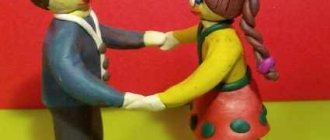Difficulty in the situation
This stage is key, as it contains at its source the main components of the structure of reflexive self-organization.
Within the framework of the chosen plot, a situation is simulated in which children are faced with a difficulty in their activity: in order to achieve their “children’s” goal, the child needs to perform a certain action, let’s call it a “trial” action. But the implementation of this “trial” action is based on that new knowledge (concept or method of action) that the child has yet to “discover” and which he does not yet have at the moment. This raises a difficulty. The teacher, using a system of questions (“Could you?” - “Why couldn’t you?”) helps children gain experience in recording the difficulty and identifying its cause.
This stage is extremely important from the point of view of the development of personal qualities and attitudes of preschoolers. Children get used to the fact that they should not be afraid of difficulties and failures, that the correct behavior in case of difficulties is not resentment or refusal of activity, but a search for the cause and its elimination. Children develop such an important quality as the ability to see their mistakes and admit: “I don’t know something yet (or I can’t do it).”
Since the difficulty is personally significant for each child (it interferes with the achievement of his “childish” goal), children have an internal need to overcome it, that is, now a new goal associated with cognition (an educational task correlated with an “adult” goal ).
In early preschool age, at the end of this stage, the teacher himself voices the goal of further cognitive activity in the form “Well done, you guessed correctly! So, we need to find out...” Based on this experience (“we need to find out”) in the older groups, a very important question arises from the point of view of solving the general task of education – the formation of the ability to learn: “What do we need to learn now?” It is at this moment that children acquire the primary experience of consciously setting an educational goal for themselves, while they pronounce it in external speech.
Thus, following the logic of the stages of technology, the teacher leads children to the point that they themselves want to learn “something.” Moreover, this “something” is absolutely concrete and understandable to children, since they themselves (under the guidance of an adult) just named the cause of the difficulty.
Inclusion of new knowledge (method of action) into the child’s knowledge system
At this stage, the teacher offers various types of activities in which new knowledge or a method of action is used in conjunction with previously mastered ones, or in changed conditions.
At the same time, the teacher pays attention to the children’s ability to listen, understand and repeat the adult’s instructions, and plan their activities (for example, in older preschool age, questions like: “What will you do now? How will you complete the task?”).
Here children acquire primary experience of self-control of their actions and control of the actions of their peers. The use at this stage of such forms of organizing children's activities, when children work in pairs or small groups for a common result, allows preschoolers to develop cultural communication skills and communication skills.
Depending on the program objectives, age and individual characteristics of the children, this stage can be implemented within one lesson (educational situation), or distributed over time.
Introduction to the situation
At this stage, conditions are created for children to develop an internal need (motivation) to participate in activities. Children record what they want to do (the so-called “children’s” goal).
To do this, the teacher, as a rule, includes children in a conversation that is necessarily related to their life experience and is personally significant for them. The sources of the formation of the situation can be real events occurring in the surrounding life (vivid natural phenomena, holidays, incidents in the lives of children and their families, events occurring in the life of a group), imaginary events, events described in fiction, etc. Emotional inclusion of children into the conversation allows the teacher to smoothly move on to the plot with which all subsequent stages will be connected.
The key phrases for completing the stage are the questions: “Do you want to?”, “Can you?”.
It is important to understand that a “children’s” goal has nothing to do with an educational (“adult”) goal. Younger preschoolers set goals related to their personal interests and immediate desires (for example, to play). And elders can set goals that are important not only for them, but also for those around them (for example, to help someone). As emphasized by L.S. Vygotsky, the most characteristic of volitional action is the free choice of a goal, one’s behavior, determined not by external circumstances, but motivated by the child himself.
By asking questions in sequence (“Do you want?” – “Can you?”), the teacher purposefully develops in children faith in their own strengths. As a result, the child learns important life attitudes: “If I really want something, I can definitely do it,” “I believe in my strength,” “I can do anything, I can overcome anything, I can do anything!”
Thus, at the “Introduction to the situation” stage, a methodologically sound motivation mechanism (“need” – “want” – “can”) is fully activated.
Updating knowledge and skills
At this stage, in the course of joint activities with children, built within the framework of the implementation of the “children’s” goal, the teacher directs the children’s activities, in which the mental operations, as well as the knowledge and experience of the children, which they need for a new “discovery,” are purposefully updated. Children develop experience in understanding the purpose of an activity, interacting with peers, coordinating actions, identifying and correcting their mistakes. At the same time, children are in their own semantic space (a game plot, for example), moving towards their “children’s” goal and do not even realize that the teacher, as a competent organizer, is leading them to new “discoveries.” Depending on the program objectives, the characteristics of the children in the group, their educational needs, this stage can be either localized in time together with other stages, or carried out separately as the threshold of a specially simulated situation of difficulty.
“Discovery” of new knowledge (way of action)
At this stage, the teacher involves children in the process of independent search and “discovery” of new knowledge, solving problematic issues.
First, the teacher encourages the children to choose a way to overcome the difficulty. In early preschool age, the main ways to overcome difficulties are to “try to guess for yourself” and/or “ask someone who knows.” In older preschool age, a new method is added - “look in a book,” “come up with it yourself, and then test yourself using a model.” Using various techniques and methods (leading dialogue, stimulating dialogue), the teacher organizes the construction of new knowledge (way of action), which is recorded by children in speech and, possibly, in signs. Thus, children gain experience in choosing a way to overcome a difficulty, putting forward and justifying hypotheses, and “discovering” new knowledge - for now by guessing.


